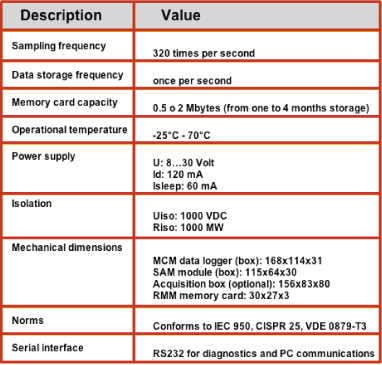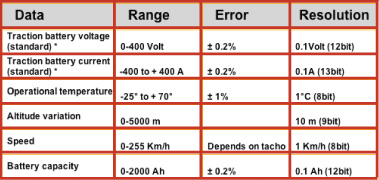Description
Pitagora's Data Acquisition System has been developed in cooperation with, and for the Mendrisio VEL project in Switzerland (Official Swiss EV project) with three main objectives:
a) acquire data, elaborate and produce all possible statistics regarding EVs, their main components and their behavior,
b) to be as simple as possible to install (non invasive), and adaptable to the complete range of EVs manufacturers and pilot projects,
c) to be a contained cost instrument, safe for the user, with the least possible user intervention.
The DAS has also been used by the Ingenieurschule from Biel in Switzerland, and is ideal for university study projects as well as for fleet management, since there is no limit to the number of vehicles that can be studied and compared.
In general terms, the DAS is made up of six elements as follows:
1. the standard kit that includes:
a) Main Control Module (which houses the altimeter and the Removable Memory Module, reads the speed reference either analog or impulses, and works as a data logger,
b) the Satellite Acquisition Module (which contains the temperature sensor and provides the voltage and current sensors, with galvanic isolation of up to 1000V so as not to bring dangerous voltages to the passenger compartment, c) the shunt we provide for current reading directly on the battery, (not necessary if there is one already in the vehicle).
2. A Transfer program that allows the user to hook up a serial RS232 cable to the Main Control Module serial port in order to download all the raw data from the RMM memory module. The Transfer program also performs data filtering and a minimum amount of analysis. After the information has been downloaded using the Transfer program, raw data is available for statistical analysis with alternative software.
3. The Analyzer program is a sophisticated but simple to use, statistical analysis program running under Microsoft Access® on Windows’95 or 98® which provides the user all necessary tools to examine EV parameters and behavior. The program offers the possibility to draw graphs and trip profiles, including altitude variations, micro and macro accelerations, current voltage and battery charge behavior, and regenerative energy under braking, all graphs related and with the possibility to progressively zoom-in on any part of the trip to inspect the related graphs and related data to the maximum precision of one second. The program also allows the user to elaborate his or her own statistics by programming in Microsoft Access®, providing the tools for the confrontation of data and statistics from different vehicles and battery manufacturers, specially useful for pilot programs, fleet study and fleet management.
4. An Optional Display to be located inside the drivers compartment on the dashboard, showing the power delivered by the battery, the altitude, the current and charge status of the battery in percentage. If required, the display can be reprogrammed to show other parameters. Programming changes must be requested from PITAGORA SA.
5. The Data Conversion Board is an interface box which allows the user to receive by mail RMMs or Removable Memory Boards from vehicle users in the field, plug them in the box, download the data and clear the memories to be sent back to the users. This box is usually connected to a Personal Computer in the office where all data from a fleet is analyzed. The RMMs are approximately one square inch boards which can be easily sent by mail to the data processing center, otherwise the inspector must go to the vehicle with a portable or laptop PC to read the information and erase the memory using the serial RS232 port in the MCM module.
6. Real time analysis is also possible by using a portable PC connected to the serial port, configured as a tool to visualize in real time as the DAS gathers the information, showing temperature, height, speed, voltage, current, and charge, second by second as the information is stored.
Items one and two make up the minimum possible configuration, meaning the user must leave the memory in the vehicle to be read using a portable or laptop PC, performing the minimum analysis with the Transfer program. Further analysis could be performed with other programs such as Excell® or Lotus®, or your own data analysis program by elaborating on the raw data gathered.
Pitagora’s Data Acquisition System will certainly assist you in demonstrating the energy savings obtained with your fleet as well as help in the design of new batteries, charger units, including information about motor performance, driving style, type of terrain, so as to implement driving courses for EVs, energy departments, and to produce ad-hoc data processing and statistical analysis if further required.
Technical data sheet

Measured Data

* Higher ranges available upon request.
Note: Pitagora SA reserves the right to change any of the information contained in this data sheet without prior notice.
Data analyzer program
E.V. Analyzer Main Application Panel
The EV Analyzer Program is based on Microsoft Access® and additional Pitagora’s own database programming which allows the user or R & D department to obtain profitable statistical profiles in graphic form regarding energy consumption, power savings, trip profiles, battery charging, discharging and battery behavior, braking regeneration energy storage, temperature variations both in motion and in parking conditions, average speed, acceleration, braking, and driving styles.
The program was further developed with the vision that one could not only paint a very complete and accurate picture of EVs and their components behavior, but of their individual drivers as well. Such drivers’ profiles can be extended by elaborating statistics by sex, or by age group, with information that shows whether the driver is a "nervous" driver or a more "conservative" one.
This opens up new developments in terms of Electric Buses in Public Transportation, Pilot projects in small towns, university programs, fleet management, control and profitability analysis making this EV Analyzer program an invaluable tool for effective energy cost analysis considering all possible variables. Furthermore, energy cost comparisons can be easily obtained between various EVs or between same model EVs powered by different batteries or power cells. Even battery manufacturers can perform comparison tests for new battery developments in a very simple, practical and cost effective way.
There is no limit to the number of vehicles that can be singularly analyzed or in the number of vehicles for a single fleet or for various fleets.
Each vehicle has its own number, model description, user information, and the time period when the data is produced. The basic Vehicle Utilization Report is the minimum information we can analyze and it provides the following analysis:
• base values for overall distance traveled, average temperature, average speed and positive acceleration.
• speed and acceleration spectrum in graphic form.
• type of route as an average per 100 km, with a positive and negative difference in height and percentages of uphill, flat and downhill travel time; also in percentage the urban, motorway or mountain travel time complemented by a graph bar or a profile graph per trip.
• percentage of utilization time, in motion, during recharging and in parking.
• driving style per 100 km. shows restarts, macro accelerations and micro accelerations.
• charge management with total charge, number of charges, average charge per 100 km, number of charges per 100 km, daytime charge and night-time charge.
• battery use average per 100 km showing charge, consumption, regenerative braking, and regenerative braking percentage.
• bar graphs indicating initial capacity spectrum and charge variation spectrum.
In terms of data analysis through tools, the capabilities of MS Access® to perform a query by selecting specific data in a certain order, or all in a class, etc. has been complemented by a progressive zoom option. This new zooming option has been developed in order to analyze in graphical form the battery charge behavior. It is possible to analyze the battery current and its voltage when the vehicle is going, for example, uphill with a slope greater than 5%, allowing the user to zoom in on specific sections of that particular trip in up to 1 second intervals.
Pitagora’s engineers will continue to develop new options for the EV Analyzer program and can offer engineering services for EV developers which require a particular acquisition or a special analysis on the obtained data, always considering practicality, functionality and with special attention for the economic aspects of each project, without disregard for the least invasive approach to the vehicle’s performance.
Program Characteristics:
• User friendliness has been the key issue when the program was developed, this is why we have chosen Microsoft Access® for full compatibility.
• A large amount of information completely and automatically controlled, using a Personal computer based on Pentium 200 MMX with 64 Mbyte Ram and a minimum of 2 Gigabyte hard disk (minimum 10 Mbytes per year per vehicle). The maximum number of vehicles to be analyzed depends only on the maximum capacity of the Hard Disk that holds the information. If your PC has a 9 Gigabyte hard disk, and allowing 1 Gbyte for program space, the remaining 8 Gbytes can be used for storing up to 800 vehicles for 1 year or 400 for 2 years or 200 for 4 years, and you can double your disk space by adding a second hard disk to your PC or for a particularly large fleet a Disk Array could be used.
• Improved possibility to select data visually.
• Ample possibilities to generate graphs using different criteria.
• Fully integrated to Microsoft Office 97®.
• Possibility to be shared in network by more than one user simultaneously.
Disclaimer Notice:
The information included in this web site may be changed without prior notice.
Microsoft Windows95-98/NT/2000® and MS Access 97® are trademarks of Microsoft Corporation.
Adobe Acrobat Reader® are trademarks of Adobe Systems Incorporated |
|
